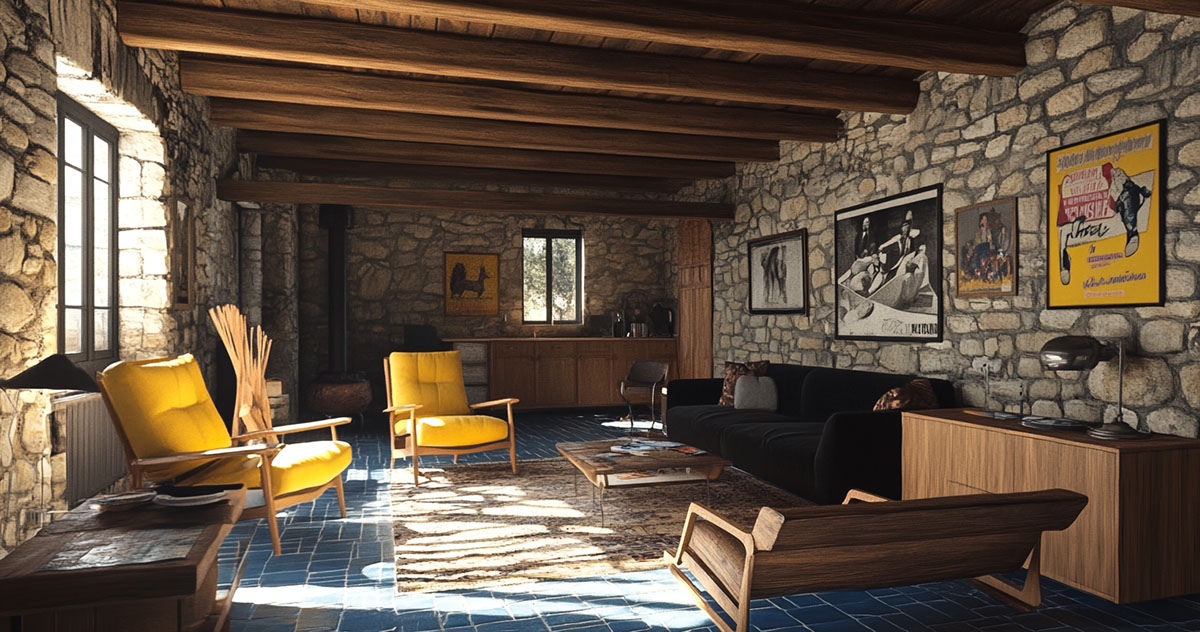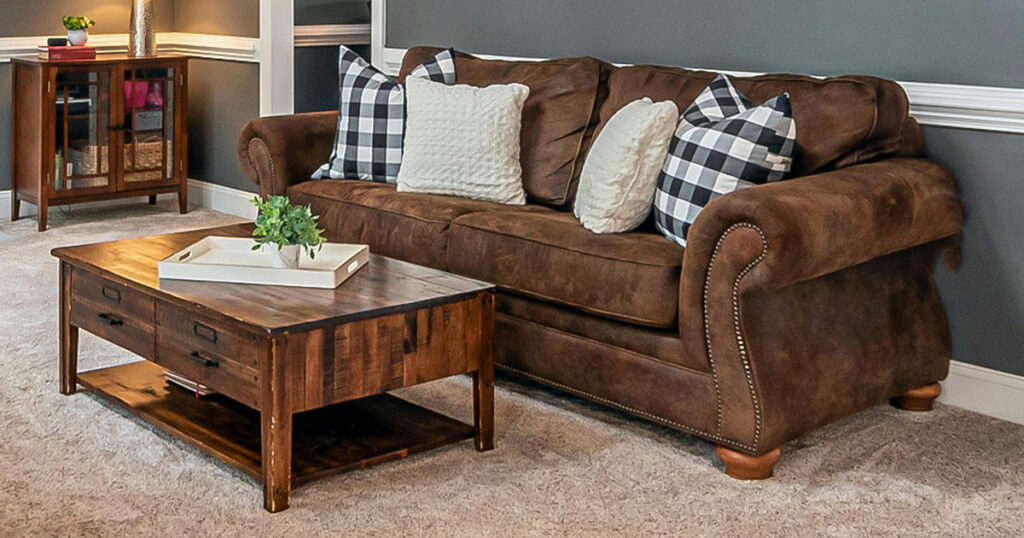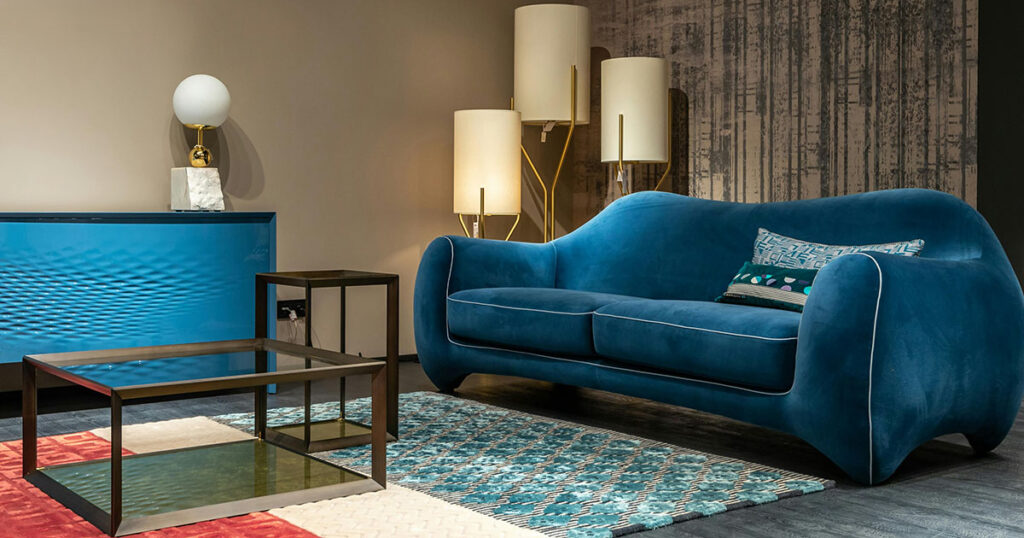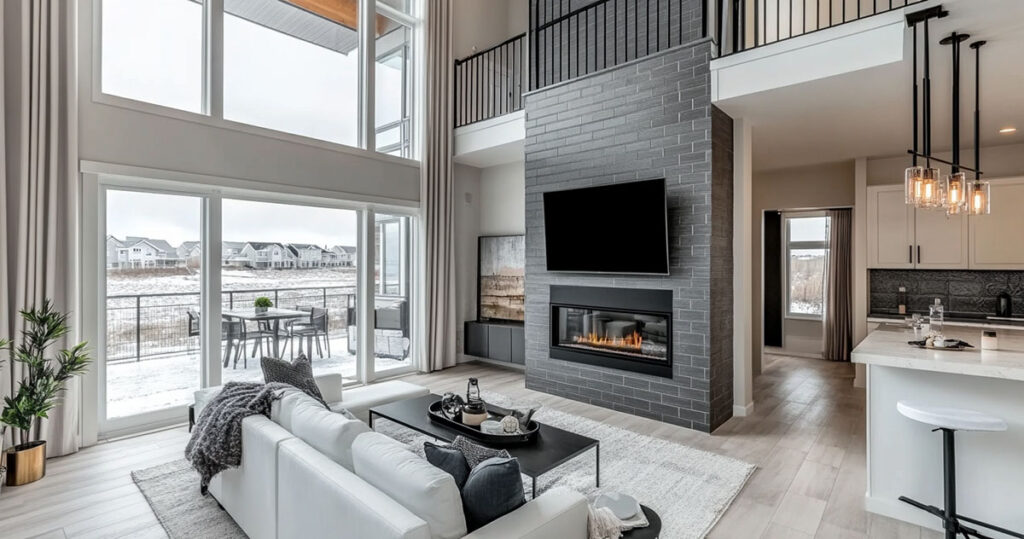Retro design styles have endured because they tell visual stories from eras defined by bold creativity, distinctive aesthetics, and cultural shifts.
A well-chosen tufted rug can anchor your retro space and become the visual foundation that ties everything together.
Let’s explore how to select the perfect rug for your retro interior, whether you’re drawn to the optimistic mid-century vibes of the 50s, the psychedelic flair of the 60s, the earthy bohemian 70s, or the bold Memphis-style 80s.
Retro Interior Styles by Decade
Each decade from the 1950s through the 1980s had its unique design language. Understanding these distinct visual vocabularies helps you select a rug that truly feels authentic to your chosen era.
1950s: Mid-Century Modern Optimism
The 1950s introduced mid-century modern design with clean lines, sleek furniture, and futuristic influences. Interiors featured organic shapes like kidney-shaped coffee tables alongside Space Age elements. The color palette mixed vibrant tones (teal, orange, chartreuse) with softer pastels (mint green, blush pink, baby blue).
For a 50s-inspired space, consider tufted rugs with geometric patterns, atomic starbursts, or boomerang designs. Choose either pastel colors that match vintage appliances or vibrant accent colors like teal or coral. A kidney-shaped tufted rug can be especially effective at evoking this era’s playful optimism.
1960s: Mod, Psychedelic, and Space-Age
The 1960s broke design rules with two main themes: “Mod” style (geometric, youthful, bold) and psychedelic/bohemian style (expressive, colorful, trippy). Colors exploded in vibrancy – oranges, electric blues, and lime greens often against crisp white, black, or gray. By the late 60s, swirling patterns and optical illusions became popular, as did shag textures.
For a 60s room, you might select a low-pile tufted rug with stark black-and-white op-art patterns or bold blocks of primary color for a mod look. For late-60s psychedelic vibes, consider rugs with swirling, abstract patterns in multiple intense colors. A deep-pile tufted shag rug in neon orange or avocado green makes for a perfect cozy focal point.
1970s: Bohemian Meets Disco
The 1970s blended laid-back bohemian comfort with flashy disco-era glamour. Colors trended toward warm, earthy tones (browns, rust orange, mustard yellow, avocado green) accented with jewel tones. Natural materials brought in a hippie vibe, while metallic finishes added disco glam. Patterns were often nature-inspired – large florals and paisley prints dominated textiles.
A 70s-inspired interior gives you freedom to play with texture and pattern. Consider a tufted rug with large floral or botanical patterns, or folk-art inspired designs that echo global textiles. Warm earth tone rugs instantly ground a room with 70s authenticity. For disco influences, try bold geometric prints in high-contrast colors. Don’t forget fringe or tassels on the edges for that casual, layered bohemian look.
1980s: Bold, Postmodern Playfulness
The 1980s exploded with bold design and postmodern twists. The Memphis Design Movement epitomized 80s style with bright hues, absurdist shapes, and pattern mixing. Color palettes included both vibrant neons (pink, electric blue, acid green) and soft pastels (mauve, baby blue, mint), often used together. Patterns could be equally loud – geometric shapes, zigzags, and even animal prints added to the eclectic aesthetic.
An 80s-inspired rug can make a bold statement. Consider a tufted rug with Memphis-style abstract shapes, zigzag lines, and squiggly figures in bright turquoise, pink, yellow, and black. Alternatively, you might choose a rug with color-blocked designs or a striking graphic motif. Don’t forget glam options like black-and-white zebra stripe patterns that add drama and energy.
Rug Colors That Harmonize with Retro Interiors
Color selection is crucial when picking a rug for your retro space. You’ll want to harmonize with the room’s vintage palette while creating visual interest.
Draw from the Room’s Palette
A fail-safe approach is to pick one of the main colors already present in your interior for your rug. For example, in a 1950s-inspired living room with teal curtains and pink accent chairs, a rug that incorporates teal will strengthen that color story and unify the room. Tufted rugs are perfect for this approach since you can often customize or find multicolor designs that include several of your room’s colors.
Use Era-Appropriate Accent Colors
Consider using your rug to introduce a particular retro accent color. Each decade has iconic hues – chartreuse or coral for the 50s, psychedelic purple or acid green for the 60s, avocado or harvest gold for the 70s, or hot pink neon for the 80s. If your room’s furniture and walls are mostly neutral, adding a rug in one of these bolder period-correct colors can energize the space while maintaining authenticity.
Mind the Mood
Think about the feeling each color creates and ensure it aligns with your desired vibe. Pastel and earth-tone rugs typically create a calmer atmosphere, while saturated brights add energy and focus.
A pastel pink rug might be perfect for a 1950s ice-cream-parlor feel or an 80s bedroom, but for a 1960s mod lounge, you might prefer the impact of electric blue underfoot.
Rug Patterns That Complement Retro Themes
Retro rugs are celebrated for their graphic patterns – from atomic-age motifs to psychedelic swirls. The pattern on your tufted rug can reinforce your retro theme or become a standout art piece.
Geometric Patterns
Geometrics are signature elements of mid-century and modernist design, as well as 80s postmodern style. For a mid-century (50s) room, choose a rug with subtle atomic starburst or diamond lattice patterns. In a 60s mod space, sharp geometrics like black-and-white checkerboard or op-art zigzags add retro punch. For an 80s room, Memphis-style geometry works perfectly: asymmetrical arrangements of shapes, grids mixed with squiggly lines, and colorblocking.
Abstract & Psychedelic Patterns
Abstract patterns are ideal for late-60s and 70s themes. Psychedelic patterns feature swirling forms, marbled effects, and often a rainbow of colors. A hand-tufted rug with a vibrant, free-form abstract pattern can instantly bring playful 60s spirit into a room. In 70s decor, free-form abstract designs influenced by modern art or nature work beautifully. A psychedelic-patterned rug can turn any living room into a groovy gathering space.
Organic and Floral Motifs
Curvilinear, organic patterns from florals to botanical prints complement 70s bohemian style beautifully. Remember that 70s florals were bold and oversized – big daisies, psychedelic flower-power designs, or tropical palm prints fit the era. Tufted rugs are ideal for this because you can get those large sweeping curves of petals and vines cut into the pile.
Customizing Tufted Rug for Maximum Retro Impact
One major advantage of tufted rugs is customization beyond just color and pattern. Paying attention to shape, edging, pile height, and scale ensures your rug matches your retro style and fits your space perfectly.
Shape Selection
Most rugs are rectangular, but retro interiors often embraced unconventional shapes. For a 1950s Atomic-Age design statement, consider a kidney-shaped tufted rug. Curved or free-form rugs can echo other rounded pieces in your room, like a 60s round cocktail table or an arching floor lamp. Round rugs were popular for conversation pits in the 70s and work wonderfully under a 60s tulip dining table. For an 80s context, irregular Memphis shapes make bold statements.
Pile Height and Texture
Tufted rugs come in various pile heights. For many retro designs, shag or high-pile rugs are direct callbacks, especially to the late 60s and 70s. A long-pile shag rug instantly introduces a cozy, casual feel and a touch of luxury. Use high pile to make larger rooms feel more intimate or to add softness alongside hard furniture lines.
Low-pile or cut-loop rugs better showcase sharp geometric patterns typical of 50s, 60s mod, and 80s designs. Low pile gives a sleeker, cleaner look ideal for mid-century modern minimalism.
Multi-level pile tufted rugs have carved or raised sections that add dimension. This technique was used in some retro rugs, particularly 80s styles. The sculpted pile can emphasize pattern motifs like making starbursts in a 50s rug stand out in relief.
Edging & Border Details
The finish or border of your rug subtly influences its style. A clean binding edge with no fringe suits mid-century modern and modernist looks. For a 50s-60s aesthetic, choose a rug with a simple edge or narrow carved border line in the same color.
Fringe or tassels enhance a bohemian 1970s feel. Some tufted rugs can be made with scalloped or cut-out edges to follow a pattern, adding extra retro flair. For more formal retro styles like Art Deco revival or mid-century Hollywood regency, consider a rug with a contrasting border pattern.
Creating Balance: Echoing or Contrasting Design Elements
Your tufted rug can either echo design elements in your retro room for harmony or contrast with them to create balance and focal points.
Echoing Colors and Motifs
To create cohesion, identify key features of your room – maybe the color of your vintage sofa, the pattern on your drapes, or a distinctive shape in your furniture. Then choose a rug that contains that color, pattern, or shape. For example, if you have a starburst wall clock and sputnik chandelier, a rug with starburst motifs will tie the room together.
Echoing is especially powerful with color: carrying an accent color from eye level down to the floor makes the whole composition feel intentional. With tufted rugs, you could even get custom designs that replicate shapes from your décor. Just remember: aim for rhythm, not redundancy – the rug should complement, not create an overly matched look.
Contrasting for Balance
Sometimes contrast is needed to balance a design. If your retro room is already pattern-heavy (common in 60s and 70s interiors with wild wallpapers and upholstery), a more solid-colored or minimally patterned rug can provide visual rest for the eyes.
Conversely, if your decor is mostly solid and simple, a bold rug pattern can serve as a striking focal point that energizes the room. The key with contrast is making it look deliberate: pick a contrasting element that still fits the era’s vocabulary.
Common Mistakes to Avoid When Selecting Retro Rugs
Even with the best intentions, there are some pitfalls to watch for when selecting a rug for your retro space:
Anachronistic Mixing
While some aesthetic crossover exists between adjacent decades, be careful not to mix elements that would never have appeared together historically. A psychedelic pattern rug would look out of place in a 1950s diner-style kitchen, just as a Memphis-pattern rug would clash with a 1970s earth-tone den.
Overdoing Pattern
Retro styles are known for their bold patterns, but too many competing patterns create visual chaos. If your wallpaper and upholstery are already pattern-heavy, consider a solid or subtly textured rug to provide balance.
Ignoring Scale
The size of your pattern matters in relation to your room. Very large patterns can overwhelm small spaces, while tiny patterns might get lost in larger rooms. Ensure your rug’s pattern scale feels proportionate to your furniture and room dimensions.
Neglecting Texture
In focusing on color and pattern, don’t forget texture’s importance in retro design. A sleek, low-pile rug might look wrong in a cozy 70s conversation pit just as a shaggy rug would seem out of place in a crisp, minimalist 50s setting.
Forcing Authenticity at the Expense of Function
While authenticity matters, remember that your space needs to serve your modern lifestyle. Some authentic retro rugs might not hold up to today’s traffic or cleaning methods. Custom tufted rugs allow you to capture retro aesthetics while using modern, durable materials.
The Value of Custom Tufted Rugs
Custom tufted rugs offer unique advantages for creating authentic retro looks:
Precise Pattern Reproduction
Tufting allows for incredibly precise pattern reproduction. Whether you want atomic starbursts, psychedelic swirls, or Memphis squiggles, a skilled tufter can create exactly what you envision.
Color Customization
Unlike vintage hunting where you’re limited to what’s available, custom tufted rugs can be made in exact color combinations to match your retro palette perfectly.
Material Selection
Custom tufting gives you control over materials, allowing you to balance authenticity with practical concerns like durability, cleanability, and allergies.
Unique Shapes
Tufted rugs can be created in any shape, from kidney-shaped 50s-inspired designs to free-form 70s organic shapes. This flexibility helps you achieve truly distinctive retro statements.
Final Thoughts
Take your time, consider the style cues of your chosen decade, and remember that retro design is all about character.
Let your rug reflect that character while grounding your space in both comfort and style.
The right tufted rug doesn’t just finish a room – it helps transport everyone who enters to a different, more vibrant time.
Whether you’re designing a commercial space with a strong thematic presence or adding vintage charm to your home, a thoughtfully selected tufted rug bridges past and present in a way that’s both authentic and livable. Happy decorating!




